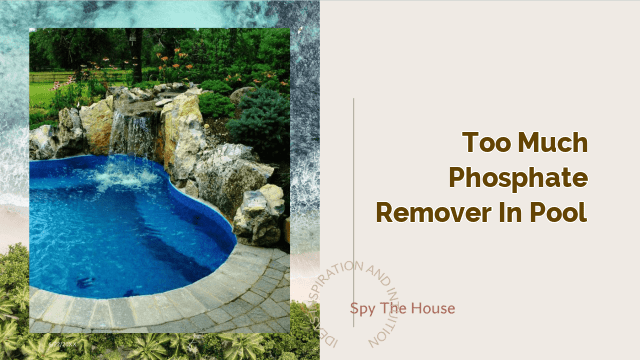Too Much Phosphate Remover in Pool
Having a swimming pool in your backyard can be a great way to cool off and relax during hot summer days. However, maintaining a pool can be a daunting task, especially if you are new to the process. One common issue that pool owners face is the accumulation of phosphates in their pool water. Phosphates are a type of nutrient that can fuel the growth of algae and other microorganisms in your pool. To combat this problem, many pool owners turn to phosphate removers. But what happens when you use too much phosphate remover in your pool? Let’s find out.
What is Phosphate Remover?
Phosphate remover is a chemical treatment that is used to eliminate phosphates from your pool water. Phosphates can enter your pool from a variety of sources, including leaves, dirt, and even rainwater. When these phosphates accumulate in your pool water, they can provide nutrients for algae and other microorganisms to grow. Phosphate remover works by binding to the phosphates and removing them from the water, making it less hospitable for these microorganisms to thrive.
What Happens When You Use Too Much Phosphate Remover?
While phosphate remover can be an effective way to keep your pool water clear and clean, using too much of it can have negative consequences. One of the most common issues that can arise from using too much phosphate remover is a decrease in the pH level of your pool water. This is because many phosphate removers are acidic in nature, which means that they can lower the pH level of your water if used excessively.
When the pH level of your pool water drops too low, it can cause a variety of problems. For example, low pH levels can cause skin and eye irritation for swimmers, as well as damage to your pool’s equipment and surfaces. Additionally, low pH levels can make it difficult for your pool’s chlorine to function properly, which can lead to the growth of algae and other microorganisms in your pool.
Another issue that can arise from using too much phosphate remover is an imbalance in your pool’s chemistry. This is because phosphate remover can also remove other important nutrients from your pool water, such as calcium and magnesium. If these nutrients are removed in excess, it can cause your pool water to become imbalanced and potentially harmful to swimmers.
How Much Phosphate Remover Should You Use?
The amount of phosphate remover that you should use in your pool depends on a variety of factors, such as the size of your pool and the concentration of phosphates in your water. As a general rule of thumb, you should follow the instructions on the label of your phosphate remover carefully, and avoid using more than the recommended amount.
It’s also important to note that phosphate remover should not be used as a substitute for proper pool maintenance. While it can be effective in removing phosphates from your water, it’s important to also regularly clean and maintain your pool to prevent the buildup of other contaminants.
How to Fix an Overdose of Phosphate Remover?
If you have accidentally used too much phosphate remover in your pool, there are a few steps that you can take to fix the issue. First, test the pH level of your pool water using a testing kit. If the pH level is too low, you can add a pH increaser to bring it back to the appropriate level.
You may also need to add other chemicals to your pool water to rebalance its chemistry. For example, if your pool water has become too acidic, you can add a calcium hardness increaser to restore the proper balance of calcium in your water. If you are unsure of how to properly balance your pool’s chemistry, it’s important to consult with a professional pool service provider for guidance.
The Importance of Proper Pool Maintenance
While using phosphate remover can be an effective way to keep your pool water clear and clean, it should not be relied upon as the sole method of pool maintenance. Proper pool maintenance involves a variety of tasks, including regular cleaning and brushing of your pool’s surfaces, maintaining the appropriate pH and chlorine levels, and checking and balancing your pool’s chemistry as needed.
By staying on top of these tasks, you can help prevent the buildup of phosphates and other contaminants in your pool water, which can help keep your pool clean and safe for swimmers. Additionally, regular maintenance can also help prolong the life of your pool’s equipment and surfaces, saving you money in the long run.
People Also Ask
What are the signs of too much phosphate in your pool?
If your pool water has too much phosphate, you may notice a few signs, such as cloudy water, green or yellow algae growth, or an unpleasant odor. These signs can indicate that the phosphate levels in your pool water are too high and that you may need to use a phosphate remover to bring them back to a safe level.
How often should you use phosphate remover in your pool?
The frequency with which you should use phosphate remover in your pool depends on a variety of factors, such as the size of your pool and the concentration of phosphates in your water. As a general rule of thumb, you should follow the instructions on the label of your phosphate remover carefully and use it as needed to keep your pool water clear and clean.
Can too much phosphate remover cause foam in a pool?
Yes, using too much phosphate remover in your pool can cause a buildup of foam in the water. This is because many phosphate removers contain surfactants, which can create foam when used in excess. If you notice foam in your pool after using phosphate remover, it’s important to adjust the amount that you are using and follow the instructions on the label carefully.
Can you swim in a pool with too much phosphate remover?
It’s generally safe to swim in a pool that has been treated with phosphate remover, as long as the chemical has been used properly and the water has been given time to properly circulate and balance its chemistry. However, if you have used too much phosphate remover in your pool, it’s important to test the water and adjust its chemistry as needed to ensure that it is safe for swimmers.
Conclusion
Using phosphate remover can be an effective way to keep your pool water clear and clean, but it’s important to use it in moderation and follow the instructions carefully. Using too much phosphate remover can cause a variety of issues, including a decrease in pH levels, an imbalance in your pool’s chemistry, and foam buildup. By staying on top of your pool’s maintenance needs and using phosphate remover as needed, you can help keep your pool safe and enjoyable for everyone.






